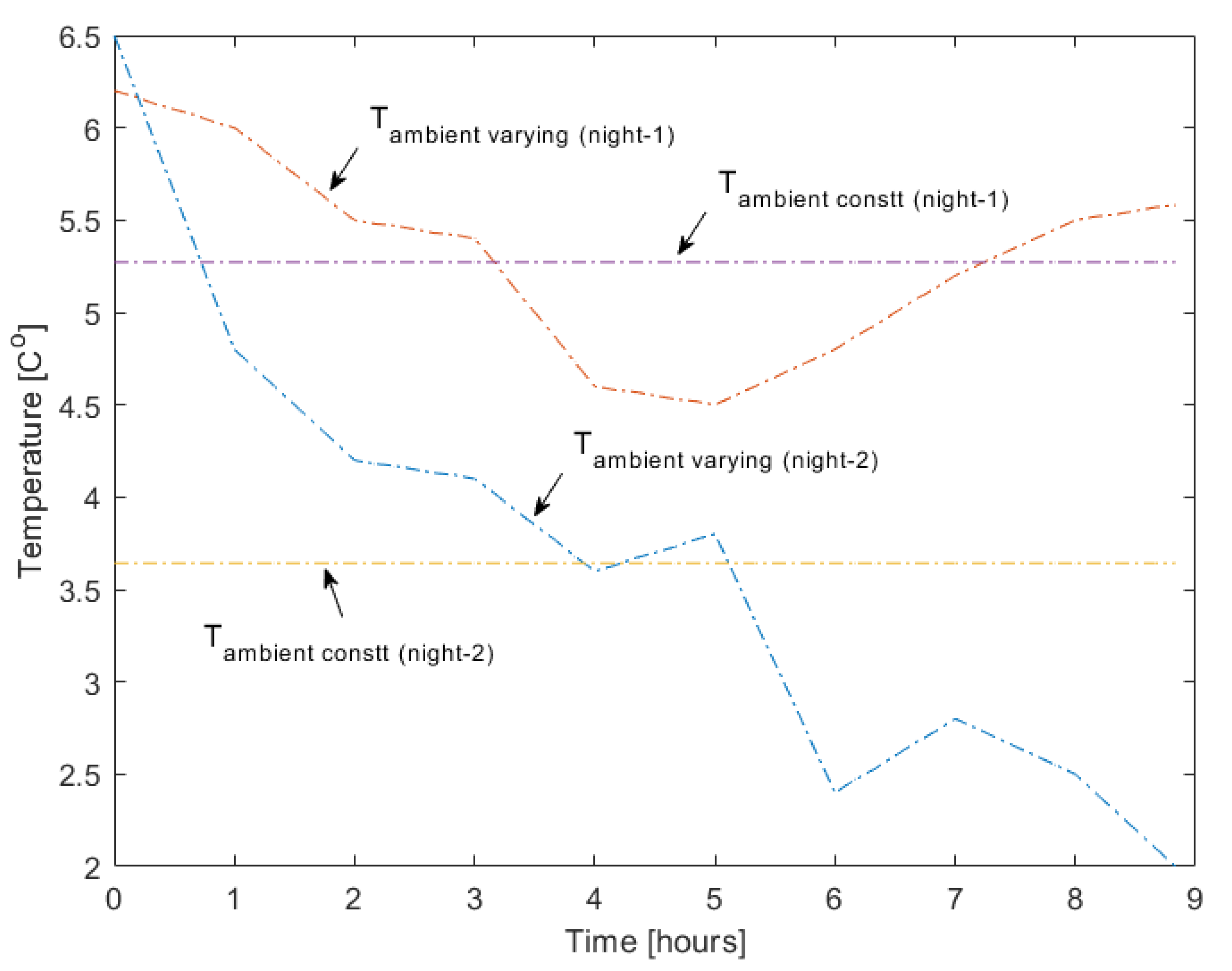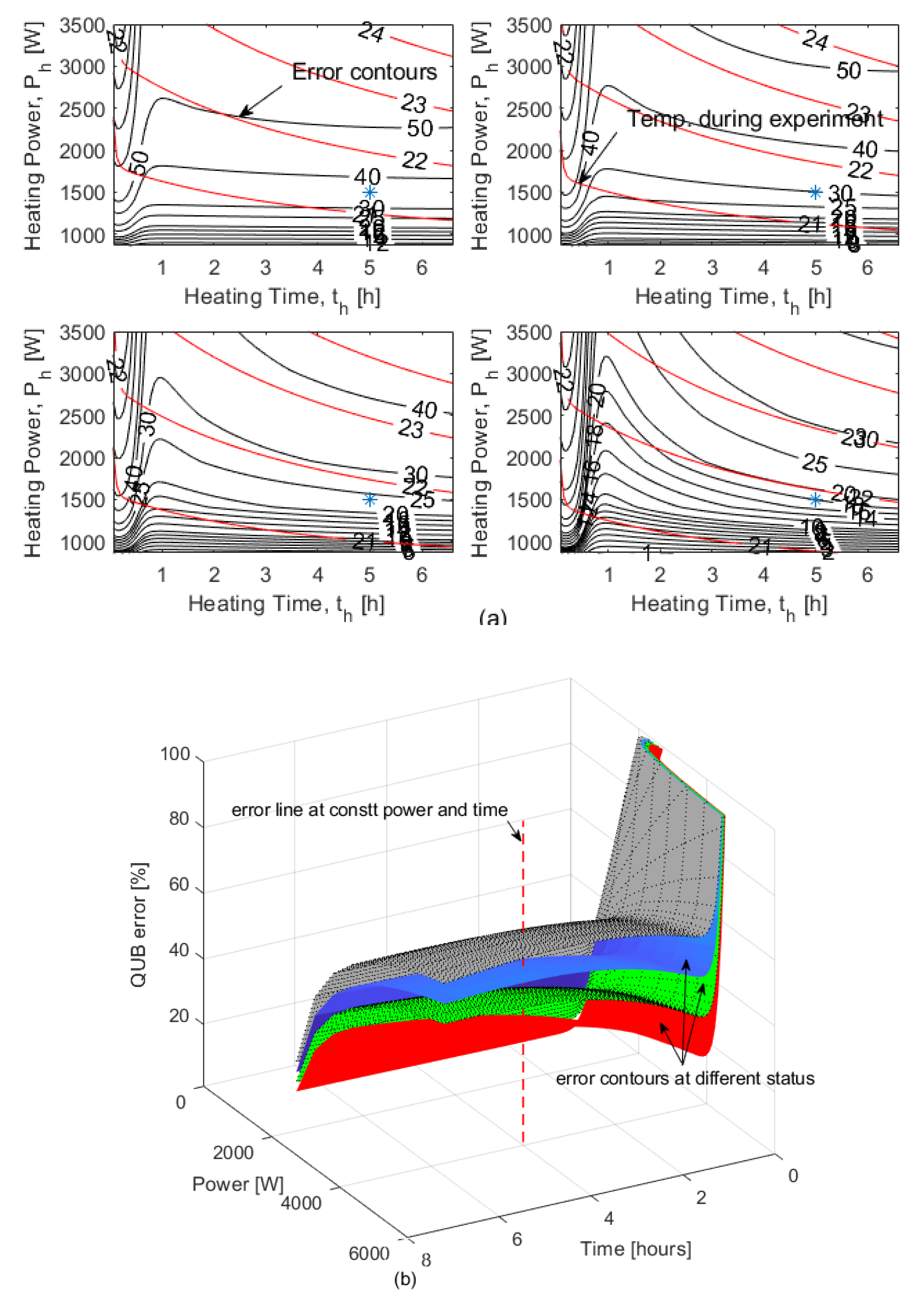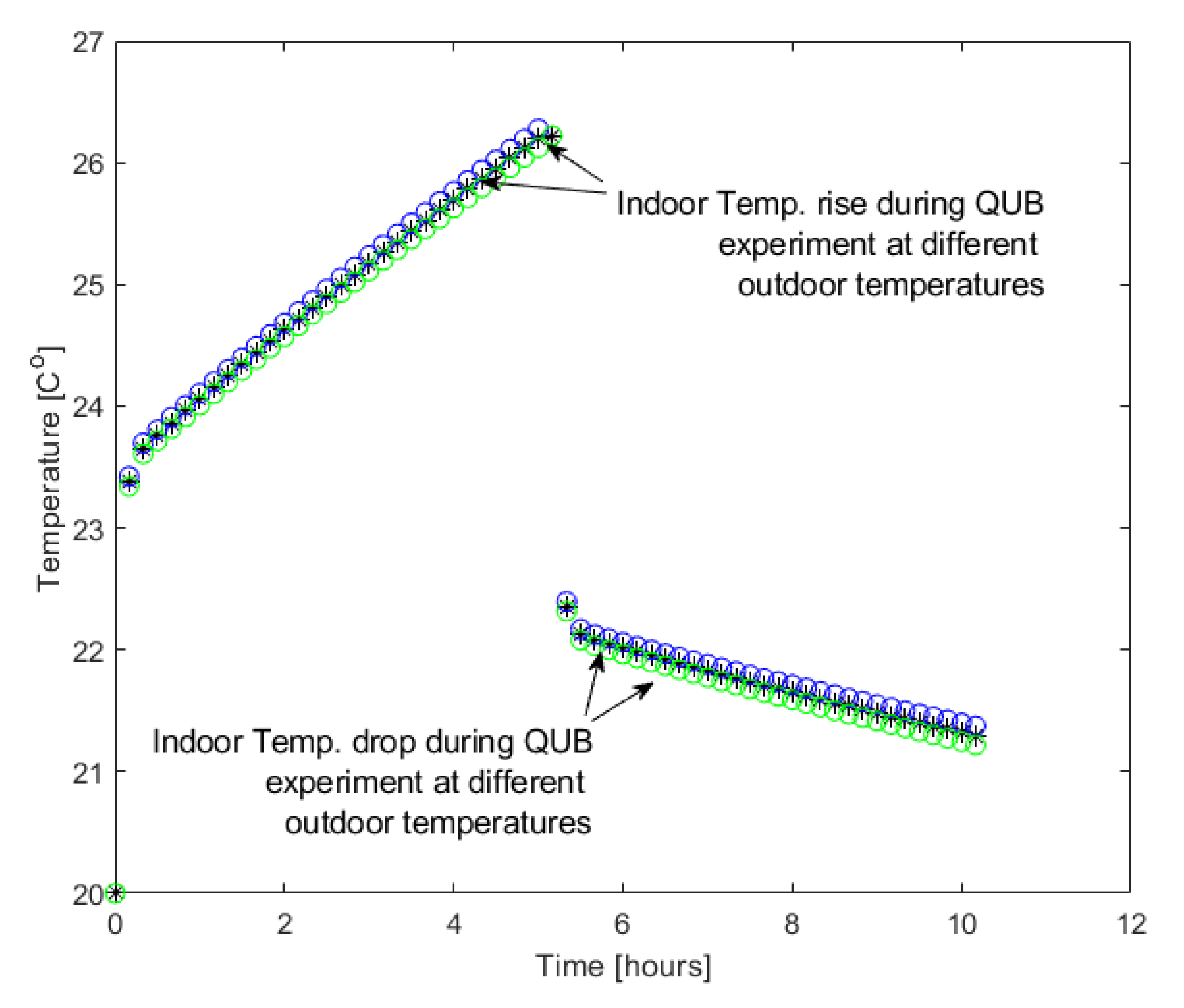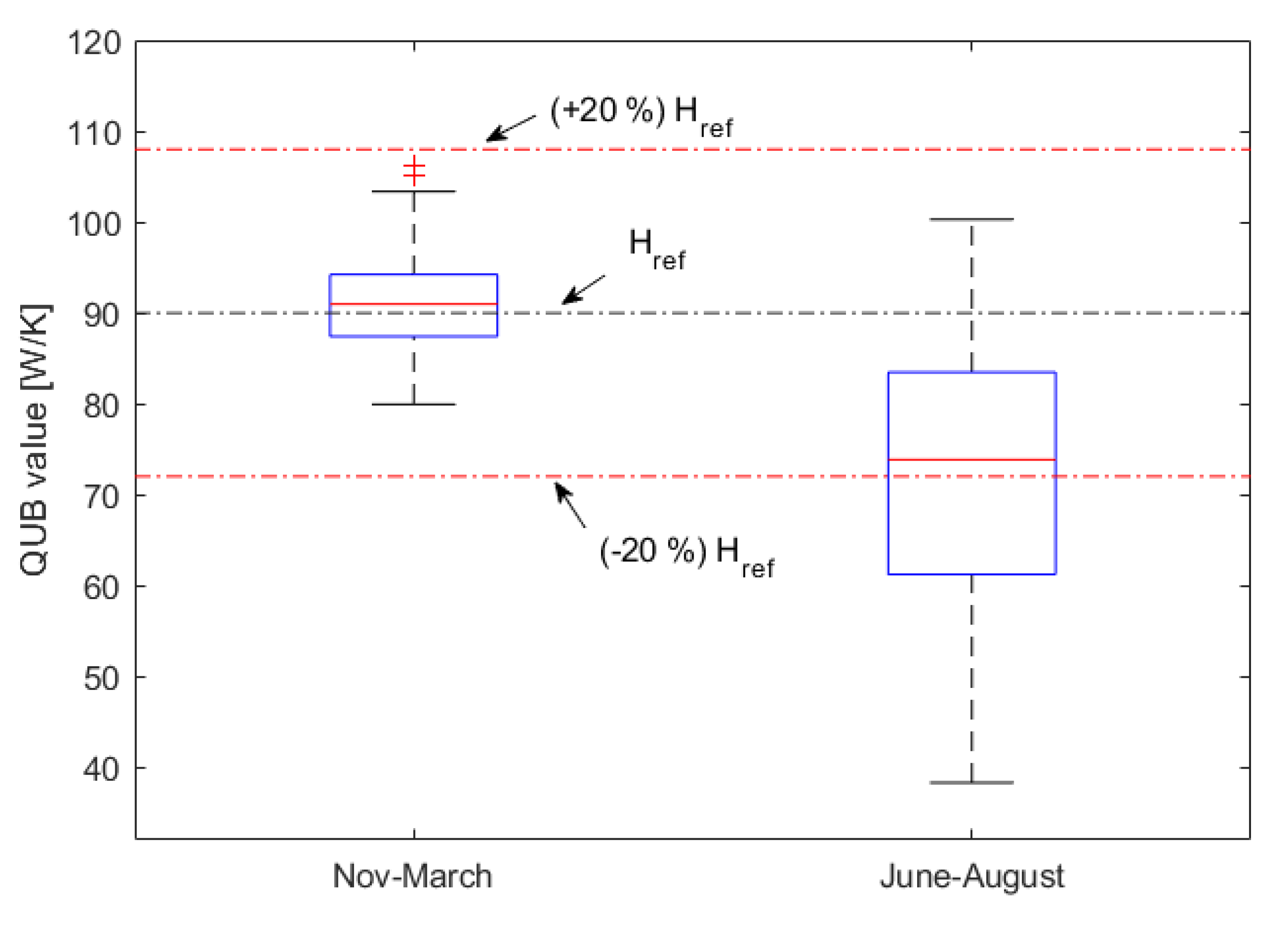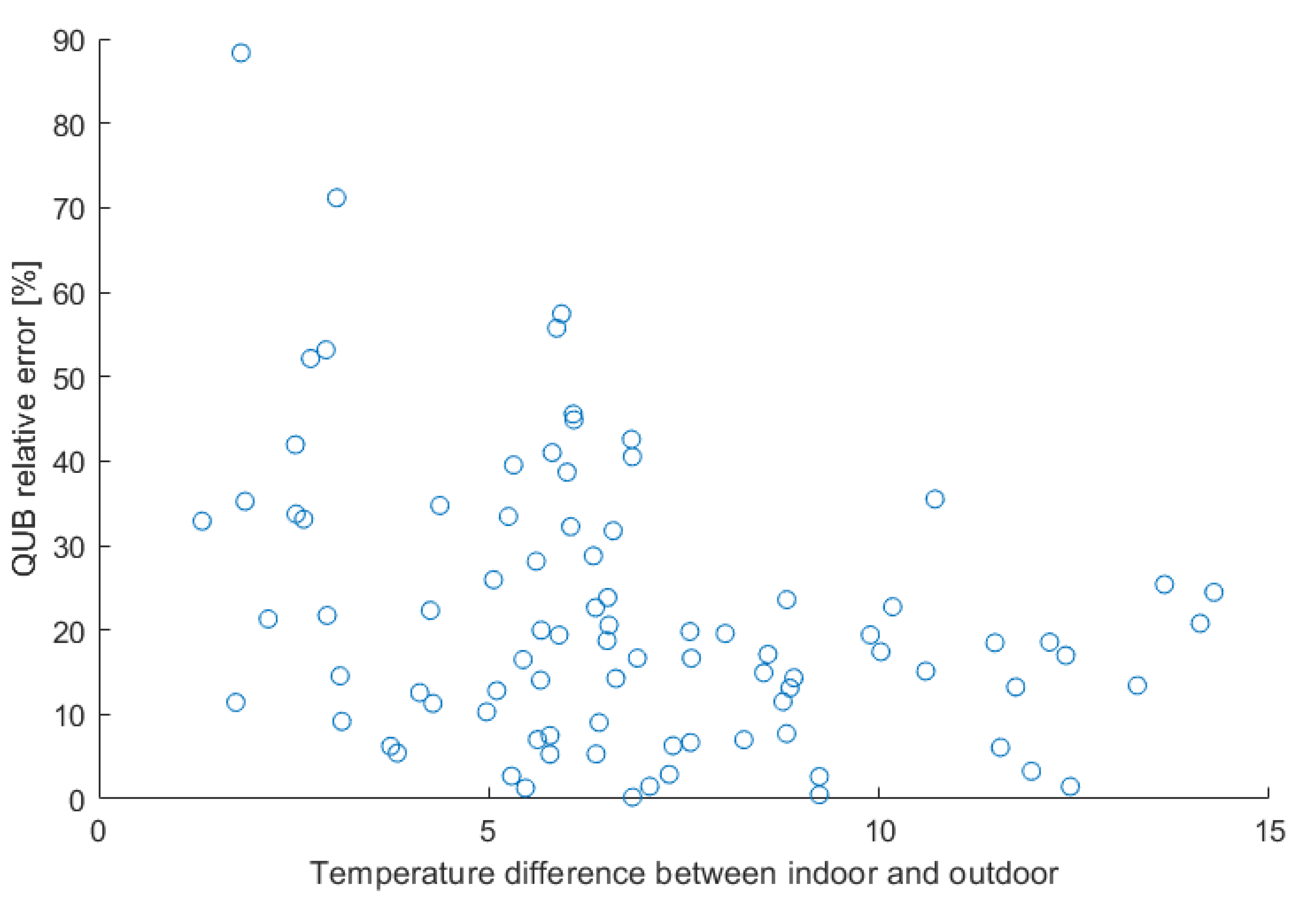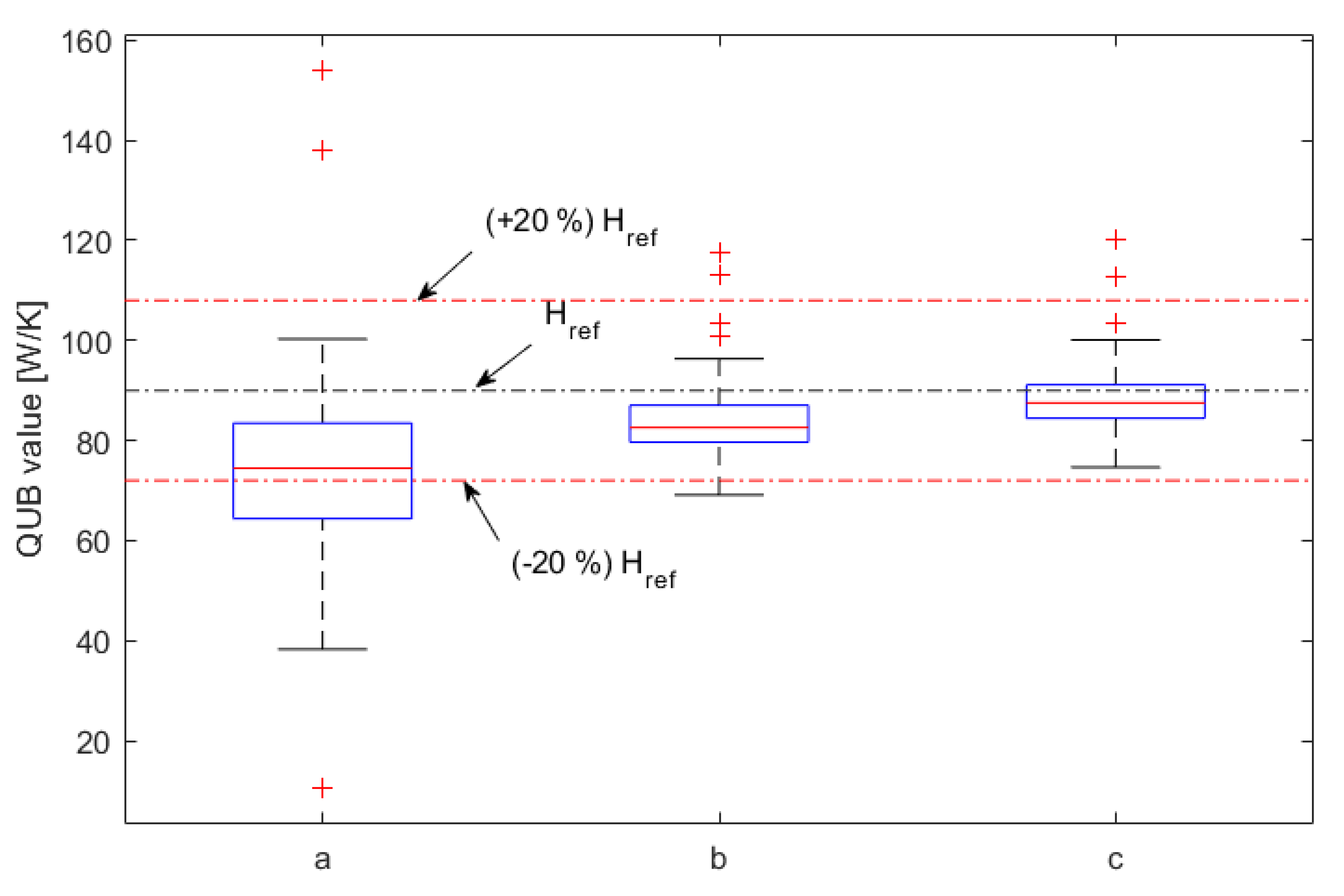1. Introduction
Significant savings can be achieved in both new and existing buildings. Depending on the level and type of retrofit (deep or shallow) and the type of building, the potential savings can range from 25% to 90% [
1]. Due to this potential, building energy efficiency sector received highest percentage (58%) of investments in energy efficiency sector in International Energy Agency (IEA) member countries (including six major emerging economies Brazil, China, India, Indonesia, Russian Federation, and Mexico) in 2017 [
2].
Energy efficiency improvements require investments that are justified against the predicted savings. The saving predictions are based on simulation of baseline annual energy consumption and are hardly realized in field over the course of time due to several factors. This difference between estimated energy consumption and the measured energy consumption is usually referred to as ‘Performance Gap’ [
3]. Some of the reasons of performance gap are deterioration of building thermal properties, reduction in efficiency of equipment, operation off the designed values, changing weather pattern, changes in operation schedule, occupancy, and inability of simulation tools to cover complete dynamics of building [
4]. A study of domestic buildings in the UK shows that savings from building envelope retrofits can be overestimated by 30% when based on calculations only [
4]. In case of old buildings, it was shown that the savings from retrofits were overestimated in 77% of cases [
4].
A better indicator of building performance is to measure the building parameters, such as overall heat transfer coefficient, solar aperture, building time constants, etc., also known as the intrinsic performance measures [
5,
6]. The intrinsic performance measures give the performance of building envelope, i.e., heating and cooling losses, free gains, etc., and remain stable with changing weather conditions, operation schedule, occupancy, etc.
The overall heat transfer coefficient
, the most popular parameter for building performance measurement [
6,
7], gives a measure of building heat loss
due to temperature difference
between the building and its environment [
8]:
This includes losses via building surfaces and infiltration. A simple equation presenting the calculation of overall heat loss coefficient
from the stated building properties is [
6,
7]:
where:
| product of heat transfer coefficient of building elements (Ui) and its area (Ai), W/K; |
| HTB | thermal bridge heat loss coefficient, W/K; |
| infiltration losses, W/K. |
Equation (1) is based on the thermal properties of the building that are used in design phase but that may change due to wear and tear, transfer of moisture through building envelope, and missing insulation layers. The overall heat transfer coefficient is, therefore, determined using onsite test methods. The common onsite test methods discussed in the literature are classified as [
8,
9]:
- -
long-term or short-term;
- -
intrusive or non-intrusive;
- -
controlled or non-controlled;
- -
measurement of individual building components such as walls, roofs, etc. or of entire building.
Based on the available data and purpose of the identification, the methods can be either steady-state or dynamic.
Co-heating, calorific test method, and flow meter test are long-term, steady-state test methods. Co-heating test method is the most common long-term method; it is considered as a reference method used as a benchmark for the other methods. The co-heating test method involves heating the building at a constant temperature and measuring the required power input, the solar radiation, and outdoor temperature during the test [
9]. The overall heat loss coefficient is estimated using [
3]:
where
| heating power supplied to keep the temperature constant, W; |
| solar power received by the building, W; |
| overall heat transfer coefficient, W/K; |
| indoor temperature of the building, K or °C; |
| ambient temperature of the external environment, K or °C. |
The required time duration for co-heating is at least two weeks but can increase up to a month. Since the method is performed in empty buildings and the duration is long, it is difficult to employ it as part of regular energy audits. Short-term test methods can be used to circumvent the problem of long duration. ISABELE (In-situ Assessment of the Building Envelope Performances), PSTAR (Primary and Secondary Terms Analysis and Renormalization), and QUB (Quick U-value of Buildings) are some of the short-term, dynamic test methods [
10,
11,
12].
PSTAR (Primary and Secondary Terms Analysis and Renormalization) is one of the earliest short-term test methods, with pioneering work by K. Subbarao [
11]. The test duration for PSTAR is three nights and four days. It involves the first step to attain steady-state conditions, followed by a free-floating period and a final step to control the indoor temperature at a given setpoint. One or more of the days during the test should be sunny to allow for determination of the solar aperture. The overall heat loss coefficient is determined by using the measurements of the last two nights. It is important to follow strict experimental protocols during the test. The PSTAR test method has repeatable results; however, they are influenced by heat losses to ground and solar radiation.
ISABELE (In-situ Assessment of the Building Envelope Performances) is a short-time method based on the response of the indoor temperature to controlled heat input. This test method identifies transmission heat transfer coefficient with a standard RC model consisting of five resistances and one capacity. The method involves observing the indoor temperature during free-floating period (no heating), followed by heating at a constant temperature and the last stage of no power input. The indoor air temperature, input power, infiltration rate, and outdoor weather conditions are measured during the test. The test duration ranges between 5 and 15 days [
12]
QUB (Quick U-Value Building) is an onsite method proposed originally by Saint Gobain [
13,
14]. It is the shortest method among the in-situ thermal performance test methods. It involves the application of power as a step input (
Figure 1). The method commences after the sunset and involves a heating phase followed by a cooling phase. The method can be performed in one or two nights [
15].
In QUB test method, the overall heat loss coefficient is estimated as [
16]:
where:
| slope of the measured indoor temperature at the end of heating phase; |
| slope of measured indoor temperature at the end of cooling phase; |
| input power during heating phase, W; |
| input power during cooling phase, W; |
| temperature difference between indoor and outdoor temperature at the end of heating phase, K or °C. |
| temperature difference between indoor and outdoor temperature at the end of cooling phase, K or °C. |
The outdoor temperature is estimated by taking the mean temperature during the night [
17].
Ideal Conditions for QUB Experiment
QUB method is based on the evolution of indoor temperature derived from the differential equation [
15]:
where:
| apparent heat capacity or thermal mass of the building, J/K; |
| indoor air temperature, K or °C; |
| power input during heating phase, W; |
| ambient/outdoor temperature, K or °C. |
| overall heat loss coefficient, W/K |
The conditions for the derivation of QUB Equation (4) from Equation (5) are that the outdoor temperature should remain constant during heating and cooling phases [
18]. A steady setpoint temperature is maintained before the experiment [
14]. The power dissipated during the cooling phase should be zero, i.e.,
. The method assumes that homogeneous internal temperature is maintained inside the building; in case of a house with many rooms, the temperature during heating and cooling phases inside each room should be ideally the same, a condition that is difficult to achieve in real experiments. There should be no air stratification (temperature difference along the height of the room) inside the zones. There are different techniques used to avoid stratification of air, i.e., using mat-heaters in vertical position for heating, fans for mixing of indoor air, or taking temperatures at different levels/heights and then taking the mean indoor temperature for QUB estimations. The test is carried with no occupants inside [
8].
Ideally, QUB experiment should start from the steady-state conditions. The literature, however, does not mention how long before QUB test an initial steady state should be maintained [
13].
The temperature evolution during QUB experiment depends on the initial internal air temperature as well as the distribution of different temperatures inside the building envelope. Before the start of QUB experiment, the building should be in steady state [
16]. The power input is from an electric heater as the heating from gas or boiler requires conversion efficiencies for power calculation that can increase the errors.
To reduce the variance of QUB results, a dimensionless quantity
is introduced [
16]:
where
is the assumed initial power before the start of QUB experiment and is given as [
15]:
where
is the temperature difference between initial indoor temperature and the average outdoor temperature during the night. Since
in Equation (2) is not known in advance of QUB experiment, it can be determined from either the design value or from calculations using envelope surface properties [
10]. The power should be optimized based on the value of
[
14]. The heating and cooling phases should be of equal durations. The theoretical model shows a strong dependence on
value. For experiments, it is recommended that
should be between 0.4 and 0.7 [
14].
The ideal conditions for QUB experiment, as discussed in this section, can be summarized as [
19]:
- -
constant outdoor temperature during the experiment;
- -
homogenous temperature inside the zone where the experiment is performed;
- -
building should be in steady-state conditions before the start of QUB experiment;
- -
equal duration of heating and cooling phases;
- -
power ratio (Equation (6)) between 0.4 to 0.7.
The robustness of QUB method was tested by both numerical and physical experiments. QUB experiments were carried out in a house with controlled environment, in a detached house, and an apartment with real weather conditions [
8,
13,
14,
16]. The results of these experiments show that QUB method can generate results within ±15% of the reference overall heat loss coefficient (
) (obtained via co-heating experiment). The simulation of QUB experiments for non-ideal weather conditions and a well-insulated house (large temperature variation during the experiment night) show that results lie within
of the reference
[
10].
A method for the design of experiment by simulation was developed in which the error can be predicted for any power and time duration [
17]. It was shown that QUB experiment can be performed with duration of time shorter than the second-largest time constant of the building and that QUB method is robust at the variation of the optimum power during the heating phase [
10,
17]. The method shows also robustness with variation in the insulation level of the building for which the experiment was originally designed such that even with
error in overall heat loss coefficient, the QUB errors lie within
of the reference value [
10].
The robustness of QUB experiment was tested on a real house [
7]. The indoor temperature was maintained at steady-state value using thermostatically controlled heaters. The house was tested between the end of September and the end of April. The experiment reported that errors for QUB test were within
of the steady-state value of the overall heat transfer coefficient. There was no influence of
criterion on the results, provided that the
-value was maintained in the range of
[
7]. When
, the results were consistently within
region. The results of the experiments performed on a real house showed that there is no correlation between the wind speed and
-value of the QUB method, although it was argued that the house was sheltered from three sides and only the west side of the house was exposed [
7]. The QUB experiments for an apartment building showed that results were in good agreement with steady-state test method. Some of the variance (with a determination coefficient of 0.21 to 0.16) in QUB results can be attributed to external temperature, where an increased external temperature can increase the
-value measured with QUB method [
8].
QUB experiments show relative robustness, as discussed in literature [
16,
18,
19,
20]. However, there is a limited experiment set that discusses the variation of QUB results with change in test conditions and insulation levels of building. The performance of the method when ideal conditions are not respected during the experiment needs to be analyzed further [
14]. In the knowledge of authors, influence of different seasons such as summer or winter was not tested. This work aims to simulate QUB experiments under non-ideal conditions during the experiment. QUB experiments are simulated for winter and summer seasons to analyze the suitability of particular season for QUB experiments. Experiments are simulated using different levels of insulation to determine the effectiveness of QUB method with building typologies.
2. Model Description and Validation
In order to simulate QUB experiments under non-ideal conditions, a dynamic state-space model is used to perform the simulations [
21]. The dynamic simulations are based on the Heat Balance method of ASHRAE [
22] using hour-by-hour typical EnergyPlus meteorological data file [
23] interpolated to obtain a timestep of 10 min. The model is generated in the steps: description of building components, generation of thermal circuits, assembling of thermal circuits, conversion of assembled circuits to state-space model, and numerical simulation of the model with weather and indoor power data [
21]. The method has the advantage of obtaining the model of the building as a single matrix. This allows us to obtain the eigenvalues and time constants of the building that can be used to analyze QUB method. The state-space modeling method also offers a transparent way of running the simulations, controlling the time step for simulation, changing the geometry of buildings, and changing layers and components of the envelope. The weather data can be manipulated conveniently to determine the influence of boundary conditions, such as solar radiations, outdoor temperature, etc. [
10].
A model calibrated on a real house is used to simulate QUB experiments. The house consists of attic, ground floor, and basement [
24]. The ground floor of the house is used for QUB experiments. The ground floor is enclosed on the top by an attic and on the bottom by a basement. Therefore, the soil and roof heat exchange is not considered in this study. The ground floor consists of seven zones: kitchen, doorway, two bedrooms, bathroom, corridor, and living room (
Figure 2). The blinds on southern face are kept closed to reduce the influence of solar radiation. The outdoor ventilation system in the house is closed during the experiments.
In addition to the experiments conducted in IEA Annex 58 [
24], QUB experiments were performed in this house for 15 days during the spring of 2014 [
14]. The cellar was kept at constant temperature of 20 °C to reduce the heat flow. QUB experiment was performed fifteen minutes after the sunset every day. Heating was done with floor mats of 115 W in vertical position to avoid air stratification; the ventilation system was turned on to further improve the temperature homogeneity of the air in the rooms [
14].
The experimental data from QUB experiments were used to validate the simulation model used for numerical QUB experiments (
Figure 3). The cellar and the attic zones were considered as boundary conditions. It can be observed that the simulation model (kitchen zone) follows the measured temperature within ±0.5 °C (
Figure 3). The increased errors on days 5 and 6 are due to the missing temperature data.
The purpose of this work is to analyze the accuracy of QUB method with changing indoor and outdoor conditions. The analysis is performed by simulating QUB experiments using the construction data of the twin house (
Figure 2) and recorded weather data [
24]. The experiments are performed by simulating the evolution of indoor temperature during the heating and cooling phases of QUB experiment with the weather conditions of the outdoor environment. An overall heat transfer coefficient obtained using steady-state method is used as benchmark for comparison with QUB experiments. Assuming that the height of each zone is the same, the steady-state overall heat transfer coefficient is [
17]:
where:
| power supplied to each zone/room of the twin house, W; |
| surface area of each room, ; |
| temperature of each room, °C; |
| outdoor temperature, °C. |
To estimate the steady-state overall heat transfer coefficient, a numerical experiment is designed by applying heating power to control the indoor air at a given setpoint temperature in steady-state conditions. The indoor air temperature and the required heating power for each zone are measured during the simulation. The overall heat transfer is then estimated using Equation (3) with heating power, temperature of each zone, and outdoor temperature as inputs. The overall heat transfer coefficient estimated in this case was 90 .



